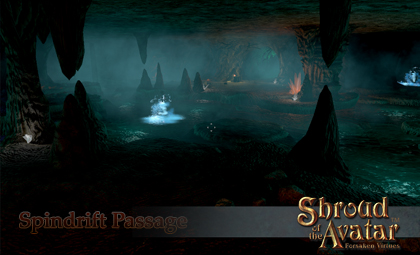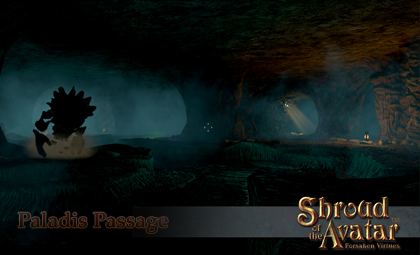Featured
Underground Passages
April 28, 2016
A view of the Spindrift Passage scene. Click for a larger image.
A view of the Paladis Passage scene. Click for a larger image.
The Shroud of the Avatar team wanted to interconnect all of its underground scenes in a vast network. A few of SotA's dungeons, sewers, and mines were already interconnected, but a primary goal was to allow players to cross the continent of Novia entirely through underground scenes.
Entry Highlights
- Scene creation (includes blockout, final worldbuilding, POI design, compass markers, ambient music, ambient FX, path grid implementation, storycraft, ambient lighting, interactable lighting, swimmable water, etc.)
- Player spawning design (includes propping for spawn points and resurrection points)
- NPC design (includes creation and placement of enemies, as well as patrol paths, ambient emotes, and visual variations)
- Combat design (includes incidental battles)
- Traps and hazards design (includes implementation of collapsing platforms, explosive objects, lava, poison gas, etc.)
- Puzzle design (includes physical puzzles [e.g. move through a trapped corridor], mental puzzles [e.g. match 3 symbols], conversational puzzles [e.g. solve an NPC's riddle], Easter eggs, etc.)
- Utilities design (includes creation and placement of scene exits, teleporters, doors, lights, crafting stations, elevators, etc.)
- Propping (includes creation and placement of interactables, breakables, secret panels, readable books, player-placeable decorations, debris, flora, rocks, etc.)
- Rewards and collectables design (includes creation and placement of harvestable resource nodes, incidental gear and treasure, quest collectables, Easter eggs, etc.)
Keith divided existing underground scenes into small, natural groups or "sectors." The enemies and harvestable resources in each scene were updated to better reflect the distributions on the surface world. He created several new underground scenes (such as Brittany Sewers) to add more substance to each sector. Players may freely travel across scenes linked within a sector.
Then, Keith created special passages to connect each underground sector to at least one other sector. Each passage was locked to keep the rate of underground travel on par with overworld travel. Players could only access a locked passages by first defeating a rare key-bearer in a free-travel scene and looting his key, then using that key to access the nearby passage to the next sector.
Each locked passage is moderately-sized and designed to fit within the fiction of its part of the world. Because Spindrift Passage lies under the large Spindrift Bay, its dripping caverns are full of deep, swimmable water, harvestable resources related to its connecting points, and water elemental enemies. Underneath a monumental lava-filled rift lies Quel Passage, with its blackened tubes, pools of lava, and fire elementals.
Tags: Catnip Games, game design, multiplayer, Portalarium, quest design, single-player, worldbuilding
